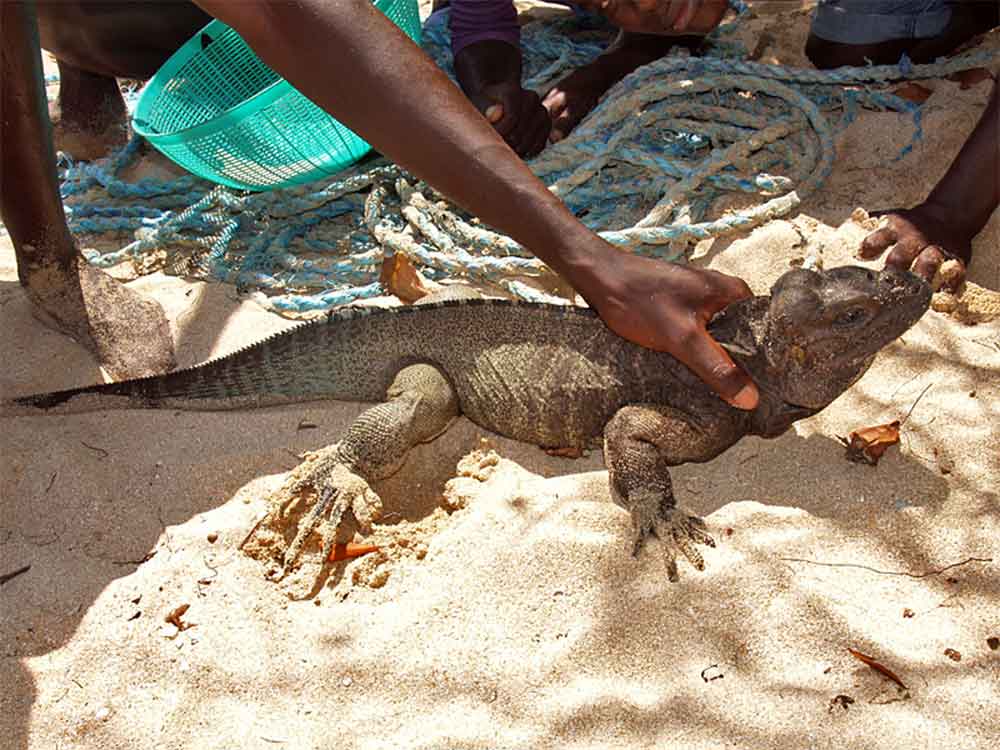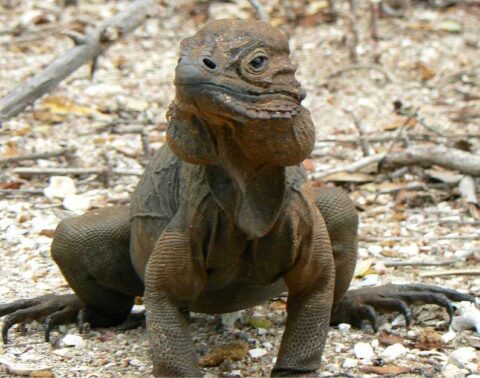
Content |
|---|
Origin / Distribution
The Rhinoceros iguana (Cyclura cornuta) It is endemic to La Española with the offshore islands Isla Beata, Petite Gonave Island, Tortoise Island, Big Island Cayemite, Island of the Petite Cayemite, Isla Saona, Kid Island (Dominican Republic and Haiti).
The subspecies:
Characteristics / Appearance
The Rhinoceros iguana it is distinguished from the Green Iguana by its dentition and the absence of the dewlap, but more conspicuously for its heavily armored tail, the upper part of which is distinguished by the fact that between three or four rows of ordinary scales there is a ring of scales which, although they are not particularly long, have turned into sharp vertical spines. The dorsal crest may be interrupted in the region of the shoulder and sacrum.
The teeth are not incisors, sino bialobulados o trilobulados, palatal teeth are small but numerous. Femoral pores are present . The males of the Rhinoceros iguana they are conspicuous by their widened back of the head with large crests. They can reach a head-torso length of about 60-70 cm and a total length of about 130 cm.. Body weights of more than 10 kg. The females are still 10 smaller cm. There is a 3-5 enlarged horn-shaped scales on snout, only indicated in females.
Habitat

The Rhinoceros iguana prefers rocky areas, dry and semi-arid sparsely populated, from sea level to the 400 m, with an annual rainfall of 470-1.000 mm and an average annual temperature of 25ºC. It is diurnal and spends the night in self-excavated or natural caves., cracks in the rocks, hollow tree trunks, etc., which he also uses during the day to rest or hide.
It has been displaced from much of its original range in La Española by habitat destruction and the introduction of predators.
Behavior
Easily excitable like all iguanas, goes into a violent rage when threatened, swells, bristle the loin, open the mouth, shows its sharp teeth, frowns at the adversary and prepares to attack. If you are provoked now, turns around quickly, strikes with a very fast lateral movement of the tail, and then you flip to the other side and repeat the same thing the same way.
Food consists of plant material such as leaves, flowers or fruits. Males are territorial and seek out territories with high, sunny spots and suitable retreats for females.. The mating season falls on the first rainy season of the year. Females probably reach sexual maturity at 2-3 years of age. They put an average of 17 (2-34) eggs, that they bury in the ground, and guard the spawn for a few days. The young are born after a few 85 days.
Threats to the species
The populations of the Rhinoceros iguana are fragmented and in decline. Thus, in 1996 the species was classified as endangered, and in 2019 a new review placed it in the category of critical danger [Red list: IN DANGER.
International trade is restricted by CITES Appendix I.
This species is also threatened by illegal poaching for food and medicinal use.. non-native species, like wild cats, dogs, mongooses and pigs, pose a risk of predation, while the herbivores, like cows and goats, compete for food sources. Habitat is often destroyed due to charcoal production, as well as development for tourism, land conversion for agriculture and bauxite mining.
In the Dominican Republic, international wildlife trade is controlled by CITES, but it is not the case of Haiti. In the Dominican Republic, iguanas are traded as pets and for tourist exhibits, known as iguana.
A local non-governmental organization, the Jaragua Group, manage conservation efforts Rhinoceros iguana in the Dominican Republic. These include monitoring and habitat restoration, outreach and education, and land acquisition. Recommended conservation measures are better law enforcement and the development of an island-wide conservation management plan..
The "Rhinoceros iguana" in captivity
The Rhinoceros iguana (Cyclura cornuta) It is one of the most requested pets by iguana keepers., but due to its size and temperature requirements it is not easy to care for.
The terrarium
Not all terrarium keepers have the possibility to offer a terrarium large enough to take care of the Rhinoceros iguana adult. An adult animal needs at least 4 m2, but you have to refrain from keeping them individually so that the iguanas can show their natural social behavior. Only in a well structured terrarium with enough places to hide and sunbathe is it possible to keep several rhinoceros iguana (also several males).
Visual barriers should serve to interrupt visual contact between individuals so that lower-ranking animals can eat and sunbathe in peace..
The enclosure must be equipped with heat and UV lamps, as well as underfloor heating. The temperature should be 30-35ºC during the day, locally higher, and drop to about 25-28ºC at night.
According to the opinion of reptile experts, a terrarium for a couple should have at least 5 times the length, 4 times the width and 3 times the head-torso height of animals. For each additional animal, a is added 15% to the basic surface.
Buy one "Rhinoceros iguana"
There is a legal trade Rhinoceros iguana bred in captivity. Potential buyers should always insist on full documentation to ensure they are not receiving illegally harvested wildlife. Illegal collection endangers the species and is detrimental to the pet trade, as wild animals often carry parasites and diseases that have been eliminated from captive-bred populations.
Its price ranges from 500 – 600 EUR.
Videos "Rhinoceros iguana"
|
|
|
|---|
Alternative names:
1. Rhinoceros iguana (English).
2. Iguane rhinocéros (French).
3. Nashornleguan (German).
4. Iguana rinoceronte, iguana Cyclura cornuta (Portuguese).
5. "Iguana rinoceronte", Iguana cornuda (español).
